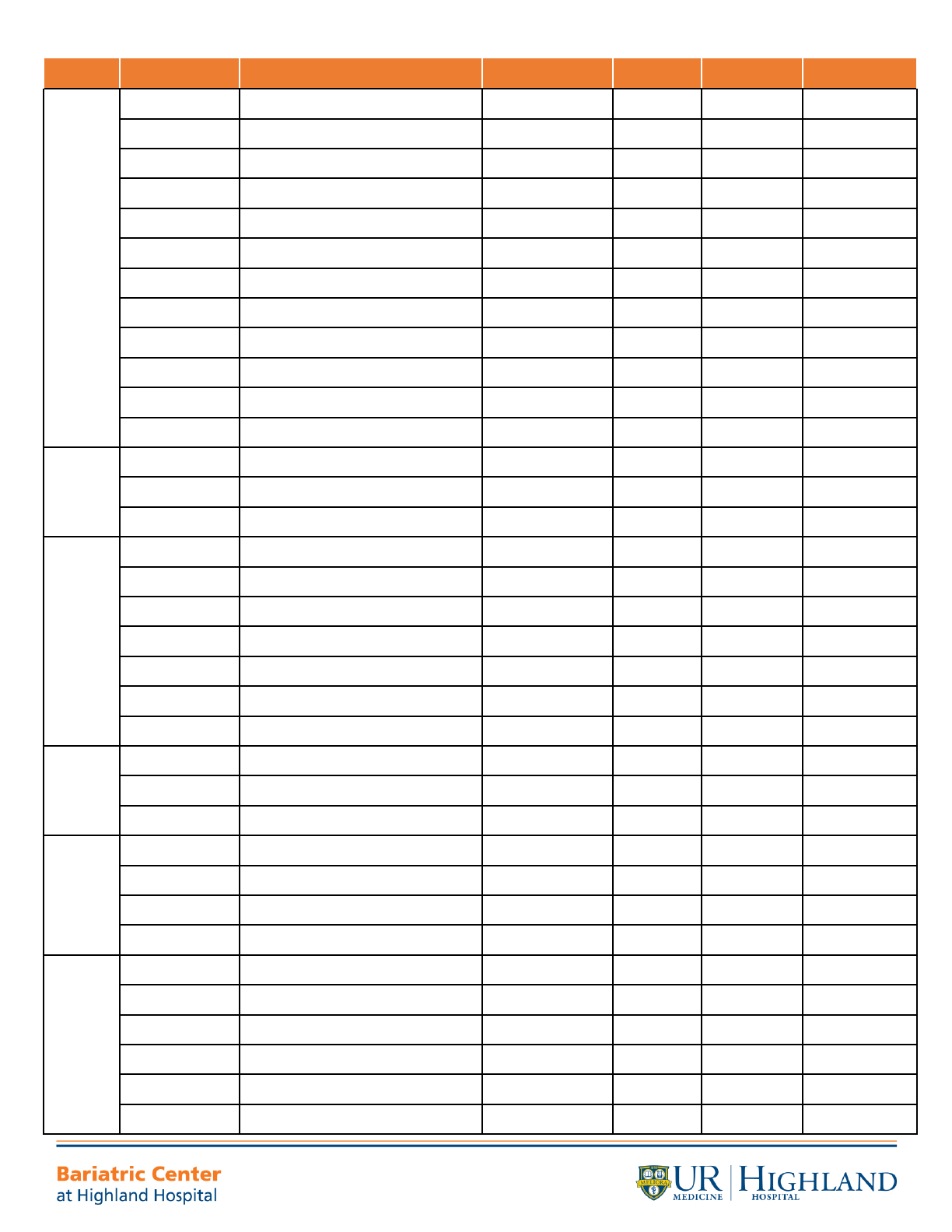
This meal plan consists of 5 – 6 small, low-fat, low sugar meals daily.
Meals should be well balanced and include:
Everyone Progresses Differently
• Protein intake should be a minimum of 60 grams daily
• Meal size should gradually increase from ¼ - ½ cup to ¾ - 1 cup portions per meal
• Introduce only one new food daily
• If new food is not tolerated the first time, reintroduce food again later in your recovery.
3 – 6 Month Bariatric Lifestyle Meal Plan
Keys to success:
• Balance each meal with protein, vegetables and fruits
• Eat every 3 – 4 hours
• Eat slowly, meals should take ~30 minutes
• Eat protein first, then follow with fruits and vegetables
• Chew foods to applesauce consistency
• Stop eating when satisfied, not overfilled
• Stop drinking 30 minutes before meals
Starches: 0 - 2 servings
Fats: 3 – 4 servings
Liquids: 48 – 64 oz. (Sugar Free)
Protein: 8 - 9 oz. (minimum)
Fruits: 1 - 3 servings
Vegetables: 3+ servings
• Do not drink during meals
• Wait 30 minutes after meals to resume drinks
• Sip drinks slowly and avoid using straws
• Begin to reintroduce raw fruits and vegetables
• Limit processed grains/starches (bread, pasta, rice, crackers)
• Avoid highly processed foods that are high in sugar and fat
• Avoid carbonated beverages
Sample Meal Plan
Breakfast
1
-2 eggs scrambled with diced tomato and 1 Tbsp. avocado
Snack
4 oz. light, low
-fat Greek yogurt mixed with 1 Tbsp. chia seeds and ¼ - ½ cup peaches
Lunch
½ cup lentils
Small baby
spinach salad with 2 Tbsp. reduced fat salad dressing
Snack
2 Tbsp. nut butter and apple slices
Dinner
2
– 3 oz. chicken
½ cup green beans
Snack
¼
- ½ cup low-fat refried beans with salsa
Food Journaling:
• It is recommended that you keep a food diary and calculate the
amount of protein you are consuming.
• If you are unable to consume at least 60 grams of protein on your
meal plan, you can continue to supplement 1 protein drink daily.

Minimum 8 – 9 oz. per day
1 oz. of protein = 8 grams of protein
Protein
Lean Meats:
• Beef (lean)
• Chicken (no skin)
• Fish/Seafood
• Pork (lean)
• Turkey (no skin)
• Tuna (Water packed)
• Venison.
• Veal (lean)
Do NOT eat:
Diary:
• 2% Milk
• Chocolate Milk
• Whole Milk
• Regular Cheese
• 4% Milk Fat Cottage Cheese
Fish:
• Canned in oil
• Fried or battered
Meats:
• Breaded
• Prime cuts
• Well-marbled
Pork:
• Bacon
• Ham hocks
• Sausage
• Spareribs
• Salami
Poultry:
• Dark meat
• Duck
• Goose
• Skin
• Wings
Other:
• Bologna
• Hot dogs
• Liverwurst
• Pepperoni
1 oz. of meat or fish = 1 oz. of protein
Bake, broil or grill. Consume loin or
round cuts of meat.
Meat Substitutes:
• Eggs
• Egg whites 2 = 1 oz.
• Whole egg with yolk 1 = oz.
• Eggbeaters ¼ cup = 1 oz.
• Legumes (beans) ½ cup = 1 oz.
• Peanut or Nut Butter 2 Tbsp. = 1 oz.
• Veggie Burger 1 patty = 2 oz.
• Bean Based Soup 1 cup = 1 oz.
• Tofu/Tempeh ½ cup = 1 oz.
• Nuts ¼ cup = 1 oz.
• Quinoa 1 cup = 1 oz. protein and 2 starches
Dairy (Low Fat):
• Milk (1% or skim) 8 fluid oz. = 1 oz.
• Soy Milk 8 fluid oz. = 1 oz.
• Flavored Yogurt (light, low-fat) 6-8 oz. = 1 oz.
• Flavored Greek Yogurt (light, low-fat) 6 oz. = 2 oz.
• Plain Yogurt (low-fat) 6-8 oz. = 1 oz.
• Plain Greek Yogurt (low-fat) 6 oz. = 2 oz.
• Cheese (low-fat) 1 oz. = 1 oz.
• Ricotta Cheese (low-fat) ½ cup = 2 oz.
• Cottage Cheese (low-fat) ½ cup = 2 oz.
Adequate Daily Protein Intake Is Essential for Optimum Nutrition and Long-term Health.
3oz.

Vegetables: 3 or more servings per day
Vegetables and Fruits
Non-Starchy Vegetables: unlimited
1 cup raw or ½ cup cooked = 1 serving
Dark Green:
• Broccoli
• Dark green leafy lettuce
• Spinach
Red & Orange:
• Carrots
• Red Pepper
• Tomatoes
Other Vegetables
• Asparagus
• Beets
• Brussels Sprouts
• Cabbage
• Cauliflower
• Celery
• Cucumber
• Eggplant
• Green or Wax Beans
• Mushrooms
• Okra
• Onions
• Turnips
Starchy Vegetables – count as starch, not vegetable
Do NOT eat:
• Vegetables prepared in cream or cheese sauce
• Fried vegetables
• Leafy greens cooked with fatty meats – try
skinless smoked turkey, liquid smoke or
skimmed chicken broth
Tips:
• Fill half your plate with vegetables
• Satisfy your appetite by choosing more
vegetable servings
• Choose raw vegetables to increase fiber
intake
• Eat a variety of different colored produce
Fruit:
• Berries 1 cup
• Fruit
• Canned ½ cup
• Dried 2 Tbsp.
• Fresh 1 medium
• Frozen 1 cup
• Juice ½ cup/day maximum
• Melon cubes 1 cup
Fruits: 1 – 3 servings per day
Fruit must be packed in water or juice with no added sugar.
Fruit juice must not contain added sugar.

0 – 2 servings per day (Portions shown below equal 1 serving)
Starch
Starchy Vegetables:
• Corn
• Peas
• Potatoes
• Root Vegetables (Tropical)
• Sweet Potatoes
• Winter Squash
• Legumes (beans)
• Kidney Beans
• Lentils
• Lima Beans
Whole Grains:
• Amaranth
• Barley
• Einkorn
• Farro
• Millet
• Oats
• Quinoa
• Wild Rice
Other:
• Broth or Tomato Based Soup
• 98% Fat-free Cream Soup
(made with fat-free milk)
• Lentil/Bean Soup
Do NOT eat:
• Biscuits
• Chow Mein Noodles
• Croissants
• Danish
• Donuts
• Fried Rice
• Fried Starches
• Muffins
• Pasta with butter, cream or cheese sauce
• Rice with butter, cream or cheese sauce
• Ramen Noodles
• White Processed Starches
• Potato Chips
• Pretzels
• Crackers
• Rice Cakes
Tips:
• Limit your starch intake at this stage.
• If you plan to eat starches, make starchy
root vegetables your first choice.
• Choose whole grain products.
Additional Starches (use 100% whole grain):
• Bagel (small) ½
• Bread 1 small slice
• Cold Cereal (no sugar coating) 1 cup
• Cooked Pasta ½ cup
• Cooked Rice ½ cup
• English Muffin ½
• Hamburger Bun ½
• Hot Dog Roll ½
• Instant Hot Cereal ½ cup
• Pancake (4 inch) ½
• Pita (4 inch) 1
• Tortilla (4 inch) 1
• Waffle (4 inch) ½
For optimum weight loss avoid
the additional starches.
½ cup
1 cup

Fats: 3 – 4 servings per day (Portions shown below equal 1 serving)
Fats, Snacks & Beverages
• Avocado 2 Tbsp. or 1/8
• Butter 1 tsp.
• Cream cheese (light) 2 Tbsp.
• Flaxseed (ground) 1 Tbsp.
• Hummus 2 Tbsp.
• Margarine
• Light 1 Tbsp.
• Regular 1 tsp.
• Mayonnaise
• Light 1 Tbsp.
• Regular 1 tsp.
• Nuts 2 Tbsp.
• Oils
• Olive Oil
• Sesame Oil
• Peanut Oil
• Grapeseed Oil
• Avocado Oil
• Olives 8 large
• Parmesan Cheese 2 Tbsp.
• Peanut / nut butter 1 Tbsp.
• Salad Dressing
• Reduced fat 2 Tbsp.
• Regular 1 Tbsp.
• Sunflower Seeds 1 Tbsp.
• Sour cream (light) 2 Tbsp.
Miscellaneous:
• Sweetener (Calorie Free)
• Spices
• Herbs
• Sugar-free Jam/Jelly
• Sugar-free Syrup
Do NOT eat:
• Cream
• Cream Cheese
• Corn syrup
• Fat Back
• Half & Half
• Honey
• Jam
• Jelly
• Lard
• Maple Syrup
• Molasses
• Palm Oil
• Pork Rinds
• Sour Cream
• Sugar (white or brown)
• Whipped Topping
Tips:
• Closely monitor portion sizes as fat is the most
concentrated source of calories .
• Choose horseradish or mustard on sandwiches
to replace mayonnaise.
• Use non-fat vegetable or margarine spray.
• Read food labels to check for added sweeteners.
• 100 – 150 calories
• Less than 9 grams of sugar
• Less than 5 grams of fat
• Use of sugar substitute is acceptable
• Water
• Flavored Water
• Decaffeinated Coffee
• Unsweetened, Decaffeinated Tea
• Sugar-free beverages
.
1 tsp.
As desired.
2 Tbsp.
Beverages: 48 – 64 oz. per day Snacks
Tips:
• No carbonated beverages
• No more than 8 oz. of caffeinated
beverages per day
• No sweetened beverages.
• Sip slowly – no more than 1 oz. at a
time

Potential Problem Foods
Some foods have difficulty passing through the opening of the stomach and may cause blockage if not
chewed well. These foods include:
• Bread (Untoasted or doughy)
• Coconut
• Dried Fruit
• Fibrous vegetables (asparagus, celery, corn)
• Membrane of citrus fruits
• Nuts
• Pasta
These foods should be eaten with caution. They should be cooked well and cut into small pieces.
Keep Active!
You must stay active to burn calories, build muscle mass and increase your metabolism. A good fitness routine will include a
combination of flexibility, cardio and strength training. Following a weekly fitness routine will increase your chances for success.
Strive to be physically active every day:
• Aim to incorporate moderate aerobic physical activity to include a minimum of 150 minutes per week (30 minutes, 5x weekly
or 50 minutes, 3x weekly)
• Walk or ride a bike, rather than drive, whenever possible
• Take a walk around your neighborhood 15 minutes in the morning and 15 minutes in the evening
• Take the stairs instead of the elevator
• Walk outside or inside around building during work breaks
• Walk around malls or large department stores
• Park further away from entrances in parking lots
• Set an alarm to get up and move every 60 minutes
• Limit use of phone time, social media, computer and TV
Establish a weekly exercise routine:
• Schedule your routine on the same day, at the same time, every week
• Strive to be active 150 minutes a week or more – three days of cardio and two days of strength training
• Your ultimate goal should be 300 minutes per week
• Peanut Butter
• Popcorn
• Red Meat (beef or pork)
• Rice
• Seeds and skins of fruit and vegetables
• Shrimp
References:
• General healthy food guidelines - choosemyplate.gov
• How to read a food label - cfsan.fda.gov
• Nutrition, fitness and behavior modifications - nal.usda.gov/fnic
• General exercise information - shapeup.org
• Eatright.org
• Highland’s support group – bariatricsupport.urmc.edu

Protein Tally: 55 – 65 grams or 8 – 9 oz.
Serving Size Protein Source Grams of Protein KCAL Protein oz. Day’s Tally
Lean Meat
3 oz. Chicken Breast 26 140
3
3 oz. Chicken Thigh – no skin 19 140
3
3 oz. Chicken Sausage 14 150
2
3 oz. Turkey – light meat 19 135
3
3 oz. Turkey – grounded, 90% lean 14 122
2
3 oz. Turkey – deli meat 14 90
2
3 oz. Turkey Sausage 23 195
3
2 oz. Turkey Bacon 8 140
1
2 oz. Canadian Bacon 10 70
2
3 oz. Beef – 95% lean sirloin 24 160
3
3 oz. Beef – ground, 95% lean 22 140
3
3oz. Pork Loin, chop 24 177
3
Fish and
Seafood
3 oz. Fish – tuna, haddock, salmon 20 100 3
3 oz. Shrimp 17 80 3
3 oz. Scallops 22 120 3
Dairy
½ cup Cottage Cheese – low-fat 14 80 2
¼ cup Ricotta Cheese – low-fat 9 113 1
1 oz. Cheese – low-fat 8 100 1
1 oz. Cheese Stick – mozzarella 1% fat 7 85 1
6 oz. Yogurt – light, low-fat , plain 5-7 80-100 1
6 oz. Greek Yogurt – light, low-fat, plain 15 100 2
1 cup Milk – skim or 1% 8 80-100 1
Eggs
2 Egg Whites 7 35 1
1 Egg 6 80 1
¼ cup Egg Beaters 6 30 1
Beans
1 cup Lentil Soup 9 150 1
½ cup Refried Beans – no fat 7 120 1
½ cup Beans (variety ) 7 100 1
½ cup Split Peas 8 120 1
Soy Products
Meatless
Vegetarian
2 Tbsp. Peanut Butter 8 200 1
1 Vegetarian Meatless Burger 15 130 2
2 Morning Star Sausage Links 9 80 1
1 cup Soy Milk 7 100 1
4 oz. Tofu/Tempe 8 117 1
1 oz. Nuts 7 159 1
